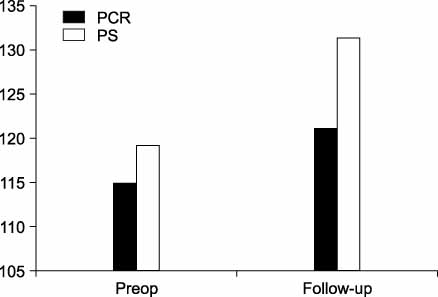J Korean Orthop Assoc.
2008 Oct;43(5):631-637. 10.4055/jkoa.2008.43.5.631.
Comparison of Posterior-Cruciate Retaining versus Substituting P.F.C. Total Knee Arthroplasty (A Randomized Study)
- Affiliations
-
- 1Department of Orthopedic Surgery, School of Medicine, Wonkwang University, Iksan, Korea. cch@wonkwang.ac.kr
- 2Department of Medicine, Wonkwang University Graduate School, Institute of Wonkwang Medical Science, Iksan, Korea.
- KMID: 2186426
- DOI: http://doi.org/10.4055/jkoa.2008.43.5.631
Abstract
-
PURPOSE: To compare the functional results of posterior cruciate-retaining (PCR) and posterior sub- stituting (PS) replacement in patients undergoing primary total knee arthroplasty (TKA) for osteoarthritis.
MATERIALS AND METHODS
A randomized controlled study was carried out to compare the clinical and radiological outcomes of PCR and PS primary P.F.C.(R) TKA. One hundred and sixty eight patients (188 cases), who had a primary diagnosis of osteoarthritis, and an intact functioning posterior cruciate ligament, were enrolled in this study. The patients were randomized regardless of the level of posterior cruciate ligament preservation. One hundred and eighty eight cases had a minimum 6-year follow-up, which included 96 and 92 cases in the PCR and PS groups, respectively.
RESULTS
The Knee Society Score, the Hospital for Special Surgery (HSS) knee rating scores, average flexion contracture and radiologic alignment improved significantly, but there were no significant difference between the two groups. On the other hand, the mean postoperative flexion angles in the PCR and PS knees increased from 114.7degrees to 121.2degrees and 119.3degrees to 131.3degrees, respectively (p<0.05).
CONCLUSION
There were no significant differences between PCR and PS TKA in the follow-up knee scores. However, the level of postoperative improvement in further flexion was better in the PS group.
Keyword
MeSH Terms
Figure
Reference
-
1. Akisue T, Stulberg BN, Bauer TW, McMahon JT, Wilde AH, Kurosaka M. Histologic evaluation of posterior cruciate ligaments from osteoarthritic knees. Clin Orthop Relat Res. 2002. 400:165–173.
Article2. Allain J, Goutallier D, Voisin MC. Macroscopic and histological assessments of the cruciate ligaments in arthrosis of the knee. Acta Orthop Scand. 2001. 72:266–269.
Article3. Andriacchi TP, Galante JO. Retention of the posterior cruciate in total knee arthroplasty. J Arthroplasty. 1988. 3:Suppl. S13–S19.
Article4. Banks SA, Markovich GD, Hodge WA. In vivo kinematics of cruciate-retaining and -substituting knee arthroplasties. J Arthroplasty. 1997. 12:297–304.
Article5. Catani F, Leardini A, Ensini A, et al. The stability of the cemented tibial component of total knee arthroplasty: posterior cruciate-retaining versus posterior-stabilized design. J Arthroplasty. 2004. 19:775–782.6. Dennis DA, Komistek RD, Hoff WA, Gabriel SM. In vivo knee kinematics derived using an inverse perspective technique. Clin Orthop Relat Res. 1996. 331:107–117.
Article7. Ewald FC. The Knee Society total knee arthroplasty roentgenographic evaluation and scoring system. Clin Orthop Relat Res. 1989. 248:9–12.
Article8. Freeman MA, Insall JN, Besser W, Walker PS, Hallel T. Excision of the cruciate ligaments in total knee replacement. Clin Orthop Relat Res. 1977. 126:209–212.9. Freeman MA, McLeod HC, Levai JP. Cementless fixation of prosthetic components in total arthroplasty of the knee and hip. Clin Orthop Relat Res. 1983. 176:88–94.
Article10. Freeman MA, Railton GT. Should the posterior cruciate ligament be retained or resected in condylar nonmeniscal knee arthroplasty? The case for resection. J Arthroplasty. 1988. 3:Suppl. S3–S12.11. Insall JN, Dorr LD, Scott RC, Scott WN. Rationale of the Knee Society clinical rating system. Clin Orthop Relat Res. 1989. 248:13–14.
Article12. Jacobs WC, Clement DJ, Wymenga AB. Retention versus removal of the posterior cruciate ligament in total knee replacement: a systematic literature review within the Cochrane framework. Acta Orthop. 2005. 76:757–768.
Article13. Maruyama S, Yoshiya S, Matsui N, Kuroda R, Kurosaka M. Functional comparison of posterior cruciate-retaining versus posterior stabilized total knee arthroplasty. J Arthroplasty. 2004. 19:349–353.
Article14. Matsuda S, Whiteside LA, White SE, McCarthy DS. Knee kinematics of posterior cruciate ligament sacrificed total knee arthroplasty. Clin Orthop Relat Res. 1997. 341:257–266.
Article15. Nelissen RG, Hogendoorn PC. Retain or sacrifice the posterior cruciate ligament in total knee arthroplasty? A histopathological study of the cruciate ligament in osteoarthritic and rheumatoid disease. J Clin Pathol. 2001. 54:381–384.
Article16. Nilsson KG, Kärrholm J, Gadegaard P. Abnormal kinematics of the artificial knee. Roentgen stereophotogrammetric analysis of 10 Miller-Galante and five New Jersey LCS knees. Acta Orthop Scand. 1991. 62:440–446.
Article17. Sorger JI, Federle D, Kirk PG, Grood E, Cochran J, Levy M. The posterior cruciate ligament in total knee arthroplasty. J Arthroplasty. 1997. 12:869–879.
Article18. Straw R, Kulkarni S, Attfield S, Wilton TJ. Posterior cruciate ligament at total knee replacement. Essential, beneficial or a hindrance? J Bone Joint Surg Br. 2003. 85:671–674.19. Stubbs G, Dahlstrom J, Papantoniou P, Cherian M. Correlation between macroscopic changes of arthrosis and the posterior cruciate ligament histology in the osteoarthritic knee. ANZ J Surg. 2005. 75:1036–1040.
Article20. Walker PS, Garg A. Range of motion in total knee arthroplasty. A computer analysis. Clin Orthop Relat Res. 1991. 262:227–235.21. Worland RL, Jessup DE, Johnson J. Posterior cruciate recession in total knee arthroplasty. J Arthroplasty. 1997. 12:70–73.
Article
- Full Text Links
- Actions
-
Cited
- CITED
-
- Close
- Share
- Similar articles
-
- Results of Posterior Cruciate Retaining and Cruciate Substituting Total Knee Arthroplasty (3 to 8 years follow up)
- Comparison of Posterior Cruciate Retaining & Substituting Total Knee Arthroplasty in Varus Deformity of Knee
- Posterior Cruciate Ligament Retaining Total Knee Arthroplasty
- Balance in Patients After TKA
- The Results of PFC Total Knee Arthroplasty: comparative study of cruciate retaining versus substitution and cement versus cementless fixation


